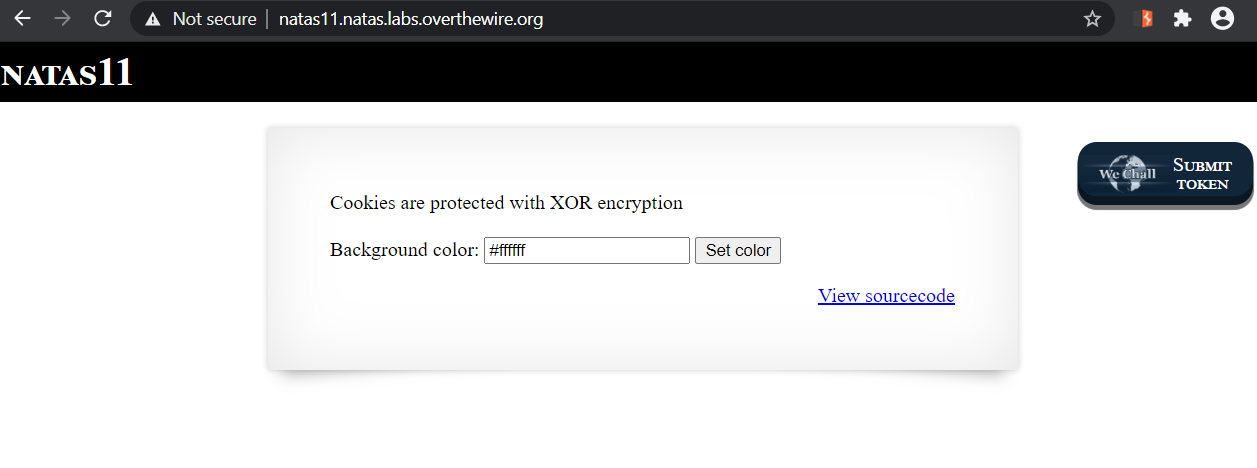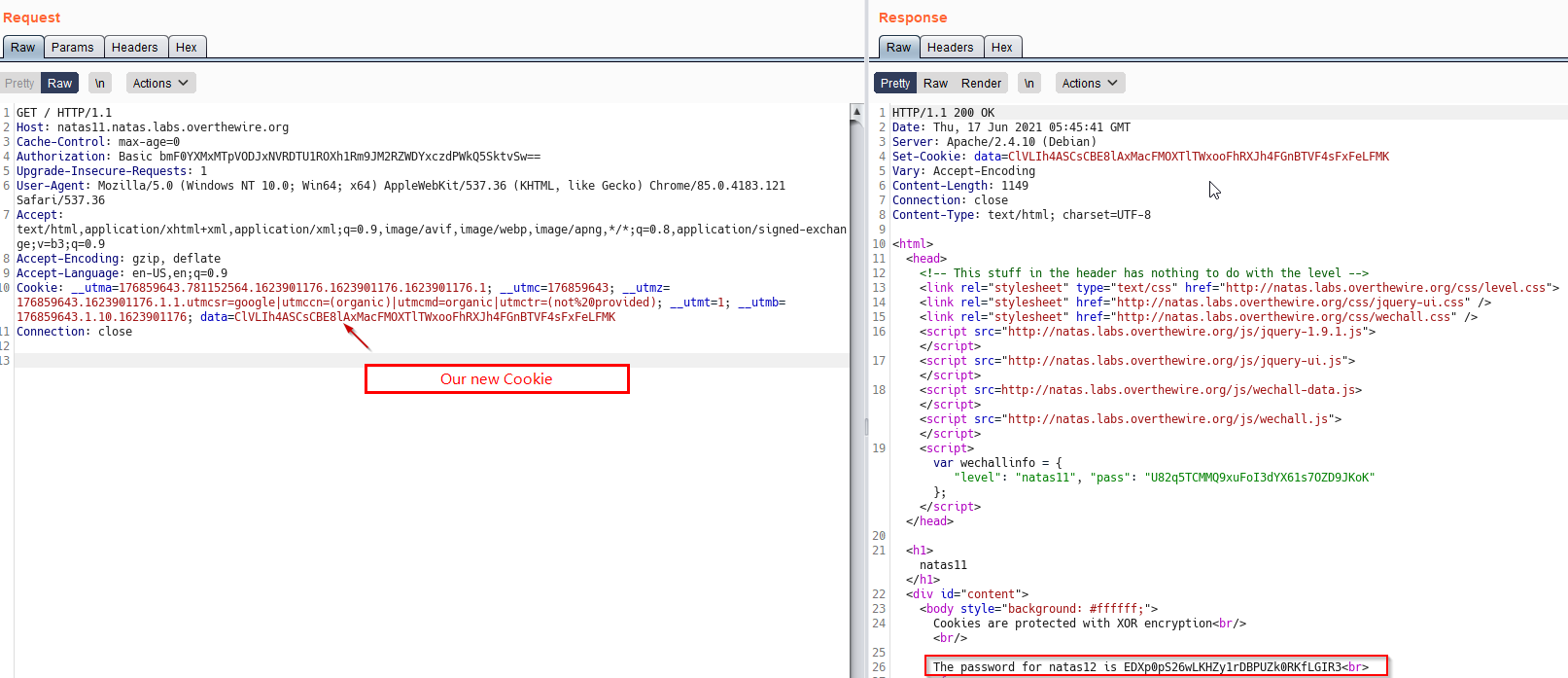Natas Level 11
This is a tricky one and challenging, it does require elaborate explanation.
Quest
We are presented with below webpage.

Below is the backened code (its quite a lot), i’ll put in some comments for now and break it down later.
<?
$defaultdata = array( "showpassword"=>"no", "bgcolor"=>"#ffffff");
function xor_encrypt($in) { // This function XOR encrypts data
$key = '<censored>';
$text = $in;
$outText = '';
// Iterate through each character
for($i=0;$i<strlen($text);$i++) {
$outText .= $text[$i] ^ $key[$i % strlen($key)];
}
return $outText; // Return the encrypted data
}
function loadData($def) {
global $_COOKIE;
$mydata = $def;
if(array_key_exists("data", $_COOKIE)) { // If data key exists in Cookie,
$tempdata = json_decode(xor_encrypt(base64_decode($_COOKIE["data"])), true); // This line decodes the data , $tempdata is an array (see below line)
if(is_array($tempdata) && array_key_exists("showpassword", $tempdata) && array_key_exists("bgcolor", $tempdata)) { //checkis if 2 keys 'showpassword' and 'bgcolor' exist
if (preg_match('/^#(?:[a-f\d]{6})$/i', $tempdata['bgcolor'])) {
$mydata['showpassword'] = $tempdata['showpassword'];
$mydata['bgcolor'] = $tempdata['bgcolor'];
}
}
}
return $mydata;
}
function saveData($d) { // Sets the Cookie for the user
setcookie("data", base64_encode(xor_encrypt(json_encode($d))));
}
$data = loadData($defaultdata); // Uses defaultdata array
if(array_key_exists("bgcolor",$_REQUEST)) {
if (preg_match('/^#(?:[a-f\d]{6})$/i', $_REQUEST['bgcolor'])) { // This regex matches color code string like #abcdd2
$data['bgcolor'] = $_REQUEST['bgcolor'];
}
}
saveData($data);
?>
<h1>natas11</h1>
<div id="content">
<body style="background: <?=$data['bgcolor']?>;">
Cookies are protected with XOR encryption<br/><br/>
<?
if($data["showpassword"] == "yes") {
print "The password for natas12 is <censored><br>";
}
?>
Solution
Before diving into the code, here is request and response in Burp

First, i’ll layout the code flow (removing function definitions)
1. Declare default array : ["showpassword"=>"no", "bgcolor"=>"#ffffff"]
2. Call loadData and save its output to variable $data
3. Modify $data[bgcolor] value as recieved in the request.
4. Call SaveData function with $data as argument to Set the Cookie
5. Lastly, if $data["showpassword"] == "yes", then reveal the password for next level.
Observation:
We can say that to reveal the password, $data should contain ["showpassword"=>"yes", "bgcolor"=>"#ffffff"]
Now $data gets its value from loadData function, so lets take a look at it.
loadData takes in the defaultarray and if no Cookie is present in the request, it returns the same default array. But in case a Cookie is sent, the Cookie is decrypted and an array is constructed, which is then returned. So, to change value of $data we set a cookie with value as ["showpassword"=>"yes", "bgcolor"=>"#ffffff"]
Onto the next part, we can’t set cookie directly like above as it is XOR encrypted, So we look at XOR encryption function.
Look at this Wiki page to understand more.
Simply put, The binary operation XOR (eXclusive OR) will compare two bits and will produce one bit in return. That bit will be equal to 1 if two compared bits were different, 0 if they were equal.
We A ^ B Below to produce C // ^ denotes XOR
A -> 00110101 01101010 // lets say with is our text (plaintext)
B -> 00001110 10100010 // this is our key ( key )
----------------------
C -> 00111011 11001000 // Our encrypted output ( cipher )
----------------------
Now, above, A^B = C . According to XOR property, C^A = B or C^B = A
If we know A and C, we can get back B, which is our "key", by simply doing a XOR again with A. (shown below)
C -> 00111011 11001000
A -> 00110101 01101010
----------------------
B -> 00001110 10100010 // Here we get our key back, if we XOR cipher with plaintext again
----------------------
At this moment, we know A (plaintext, i.e. array) and C (Ciphertext, i.e cookie data). Now we will use the xor encrypt function to get B .i.e. key
$A = json_encode(array( "showpassword"=>"no", "bgcolor"=>"#ffffff"));
$C = base64_decode("ClVLIh4ASCsCBE8lAxMacFMZV2hdVVotEhhUJQNVAmhSEV57Q0ReaAw="); // Cookie taken from burp
// Above we removed the preprosessing before XORing as same happens in source code.
// Copied code from sourcecode and modified slightly
function xor_encrypt($in, $key) {
$text = $in;
$outText = '';
// Iterate through each character
for($i=0;$i<strlen($text);$i++) {
$outText .= $text[$i] ^ $key[$i % strlen($key)];
}
return $outText;
}
echo xor_encrypt($C, $A); // gives output qw8Jqw8Jqw8Jqw8Jqw8Jqw8Jqw8Jqw8J
// This is our key as to do xor 'qw8J' is repreated
Now that we have key, .i.e. B and we know A, we can create a valid new C
$newA = json_encode(array( "showpassword"=>"yes", "bgcolor"=>"#ffffff"));
$B = 'qw8J';
echo xor_encrypt($newA, $B); // UK"H+O%pS]9S[(W&pST^,^,S
// Now we base64 encode it
echo base64_encode(xor_encrypt($newA, $B)); // ClVLIh4ASCsCBE8lAxMacFMOXTlTWxooFhRXJh4FGnBTVF4sFxFeLFMK
// This is our Cookie
Using Burp Repeater, send our newly created C as the Cookie, which reveals the password as seen below.
